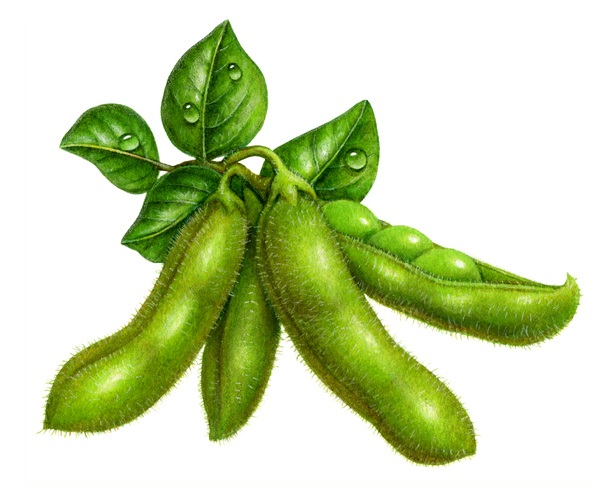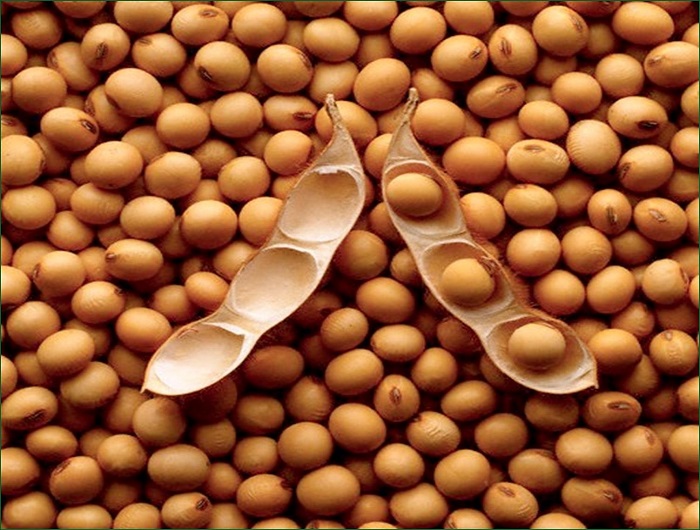Main Name: Soybeans
Biological Name: Glycine max
Names in other languages: Alubias de soja (Spanish), Soya (French), Soybean (Hindi)
Biological Name: Glycine max
Names in other languages: Alubias de soja (Spanish), Soya (French), Soybean (Hindi)
Are you planning to turn into a vegetarian and bid adieu to the healthy meat and seafood diet? But do you still worry about how to fulfill your daily protein requirement? Well, there are soybeans that are purely vegetarian and take care of your protein requirement completely and are great health promoters. They are assumed to be non-vegetarian by most people due to their high resemblance to meat and are often left aside. Native to Southeast Asia, soybeans are a member of the legume family and are botanically known as Glycine max. It is due to their rich oil and protein content that they are extensively cultivated round the globe. Soybean products come in a plethora of forms, such as soy milk, soy sauce, fermented bean paste, natto, tempeh, soybean oil and others. Whether it is cardiovascular health, cancer, osteoporosis or menopause, soybeans deal with every disease effectively. Discover the protective properties of soybeans as you leaf through the sections below.
History
The history of soybeans tracks 13,000 years back and is believed to have originated in China. In the 8th century, they were introduced in Japan and with passing centuries, they spread to other regions of Asia including India, Thailand, Malaysia, Korea and Vietnam. Soybeans were first introduced in the United States in the 18th century, planted by an American who brought them back from China. Even though American farmers had began planting soybeans in the 19th century, they didn’t receive much public attention until early 20th century, when nutrition pioneers such as George Washington Carver and John Harvey Kellogg discovered and promoted the health benefits of soybeans. Since then, the general interest in the nutritional benefits of soybeans has steadily increased. In the past few years, widespread interest has occurred in soybeans which can be credited to the recent scientific research that is supporting the numerous ways in which soybeans promotes health. Currently, United States is the leading producer of soybeans, followed by Brazil, Argentina, China and India.
The history of soybeans tracks 13,000 years back and is believed to have originated in China. In the 8th century, they were introduced in Japan and with passing centuries, they spread to other regions of Asia including India, Thailand, Malaysia, Korea and Vietnam. Soybeans were first introduced in the United States in the 18th century, planted by an American who brought them back from China. Even though American farmers had began planting soybeans in the 19th century, they didn’t receive much public attention until early 20th century, when nutrition pioneers such as George Washington Carver and John Harvey Kellogg discovered and promoted the health benefits of soybeans. Since then, the general interest in the nutritional benefits of soybeans has steadily increased. In the past few years, widespread interest has occurred in soybeans which can be credited to the recent scientific research that is supporting the numerous ways in which soybeans promotes health. Currently, United States is the leading producer of soybeans, followed by Brazil, Argentina, China and India.
 https://foodartist.wordpress.com/2010/09/28/35-illustrating-as-my-remedy/
https://foodartist.wordpress.com/2010/09/28/35-illustrating-as-my-remedy/
Health Benefits of Soybeans
- Increased consumption of soy foods is very effective in reducing LDL cholesterol. Studies have revealed that soy protein is beneficial in lowering plasma cholesterol, LDL cholesterol and triglyceride concentrations.
- Recent studies show that isoflavones, daidzein and genistein found in soybeans are protective against breast, colon and prostate cancer. These two isoflavones act as phytoestrogens which further help in reducing the effects of estrogen and neutralizing some of estrogen’s cancer causing potentials.
- Consuming soy products on a regular basis lowers the risk of coronary artery disease due to considerable reductions in blood lipids, LDL cholesterol, homocysteine and blood pressure.
- Soybeans are very helpful in losing weight since they are good sources of high-fiber which contribute to weight loss efforts when substituted with higher calorie foods. Soybeans provide feelings of satiety and fullness in between meals and reduce hunger cravings. Eventually, this helps in preventing unnecessary eating and excessive calories which can otherwise lead to weight gain.
- Soybeans contain omega-3 fatty acids which are necessary for a healthy heart. These essential omega-3 fatty acids reduce the risk of coronary heart disease. Even though soybeans contain higher fat content as compared to other beans, like pinto beans and navy beans, they also possess these heart-healthy omega-3 fatty acids.
- Lecithin present in soybeans reduces blood cholesterol, which provides protection against the development and hardening of arteries, and prevents compilations of the heart, brain, kidneys and eyes.
- To add on, this lecithin is known to increase the gamma globulin content of the blood, which in turn, is associated with increasing immunity and protecting against the attack of various infections.
- Soybeans are highly essential for preventing diabetes due to their lower glycemic index, which helps in keeping blood sugar levels more stable, thereby making diabetes much easier to control. Soybeans are high in dietary fiber, which helps in stabilizing blood sugar levels.
- Menopausal women are extremely benefited with soybeans as they reduce hot flushes and protect the bones from becoming weak and brittle. Since post-menopausal women face an increased risk for osteoporosis, soybeans help in keeping the bones healthy.
Soybeans Nutrition FactsAmount: 1 cup
Weight: 186 g
Weight: 186 g
| Nutrients | Amount |
| Basic Components | |
| Proteins | 68 g |
| Water | 15.9 g |
| Ash | 9.1 g |
| Phytosterols | 299 mg |
| Calories | |
| Total Calories | 830 |
| Calories From Carbohydrates | 224 |
| Calories From Fats | 334 |
| Calories From Proteins | 271 |
| Carbohydrates | |
| Total Carbohydrates | 56 g |
| Dietary Fiber | 17 g |
| Sugar | 14 g |
| Fats & Fatty Acids | |
| Total Fat | 37 g |
| Saturated Fat | 5.4 g |
| Monounsaturated Fat | 8.2 g |
| Polyunsaturated Fat | 21 g |
| Omega-3 Fatty Acids | 2.5 g |
| Omega-6 Fatty Acids | 18 g |
| Vitamins | |
| Vitamin A | 41 IU |
| Vitamin C | 11 mg |
| Vitamin E | 1.6 mg |
| Vitamin K | 87 mcg |
| Thiamin | 1.6 mg |
| Riboflavin | 1.6 mg |
| Niacin | 3 mg |
| Vitamin B6 | 701 mcg |
| Folate | 698 mcg |
| Pantothenic Acid | 1.5 mg |
| Choline | 216 mg |
| Betaine | 3.9 mg |
| Minerals | |
| Calcium | 515 mg |
| Iron | 29 mg |
| Magnesium | 521 mg |
| Phosphorus | 1.3 g |
| Potassium | 3.3 g |
| Sodium | 3.7 mg |
| Zinc | 9.1 mg |
| Copper | 3.1 mg |
| Manganese | 4.7 mg |
| Selenium | 33 mcg |
 http://www.commodityonline.com/news/soybean-may-see-bull-run-as-govt-hikes-duty-on-edible-oils-61128-3-61129.html
http://www.commodityonline.com/news/soybean-may-see-bull-run-as-govt-hikes-duty-on-edible-oils-61128-3-61129.html
How many calories in soybeans (per 100 gm)
Soybeans have about 446 calories per 100 gm of weight.
Soybeans have about 446 calories per 100 gm of weight.
How to Buy Soybeans
- Soybeans are available in both prepackaged containers as well as bulk bins. While purchasing soybeans in bulk, make sure that the bins are properly covered.
- It is recommended to buy soybeans from a store with a good product turnover to ensure its maximal freshness.
- Always check for any signs of moisture or insect damage while buying soybeans. Also, note that the soybeans are whole and not cracked.
- Canning of foods reduces their nutritional value. Even though if you enjoy canned soybeans, avoid buying ones that contain extra salt or additives.
Soybeans Storage Tips
- Dried soybeans, when stored in an airtight container in a cool, dry and dark place, can easily be kept for up to twelve months.
- Soybeans bought at different time periods require different cooking times depending upon their dryness level. As such, soybeans purchased at different times should be stored separately.
- Cooked soybeans should be stored in a tightly sealed container in the refrigerator. This way, they retain their freshness for three days.

